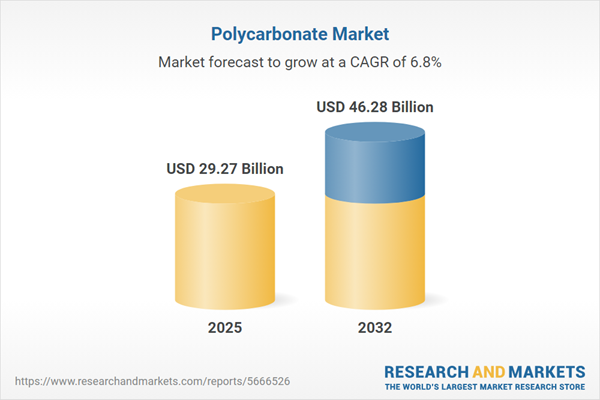Speak directly to the analyst to clarify any post sales queries you may have.
The polycarbonate market is evolving as executives address sustainability demands, new technologies, and shifting regulations. Effective strategies are essential to seize growth opportunities, adapt to risk, and achieve operational flexibility.
Market Snapshot: Polycarbonate Market Overview
The global polycarbonate market attained a valuation of USD 27.41 billion in 2024 and is forecast to reach USD 29.27 billion in 2025, eventually rising to USD 46.28 billion by 2032 with a compound annual growth rate (CAGR) of 6.76%. Market momentum is driven by sustained technical innovation in sectors where high-performance materials are needed under challenging conditions, such as elevated temperatures and mechanical stress. Stringent regulatory compliance and the extension of polycarbonate usage across numerous industries are also promoting growth. Policymakers play a substantial role in shaping industry trends, while organizations strategically navigating these changes maintain a competitive edge and adapt to increasingly dynamic market needs.
Scope & Segmentation in the Polycarbonate Industry
- Applications: Polycarbonate enhances impact resistance in automotive and transportation, delivers advanced glazing and insulation capabilities for construction, bolsters medical devices focusing on safety, and supports the miniaturization and improved safety required in electrical and electronics. This versatile material also serves industrial sectors demanding chemical durability and adaptation to diverse operational requirements.
- Product Forms: Available as molding pellets, rods, tubes, co-extruded sheets, multiwall sheets, solid sheets, and specialty films, polycarbonate allows tailored solutions for manufacturers across a broad spectrum of applications and ensures adaptability throughout the production process.
- Processing Techniques: The industry utilizes processes such as blow molding, extrusion, and injection molding. These technologies enable scalable production, help meet compliance benchmarks, and allow for rapid adaptation as market demands and regulatory expectations shift.
- Grades Available: Suppliers offer specialized grades—such as flame retardant, UV stabilized, high heat resistant, and standard formulations—addressing critical safety and performance standards, particularly in construction and electronics environments.
- Regional Dynamics: The polycarbonate sector features active participation across the Americas, Western Europe, the Middle East and Africa, and Asia-Pacific. Each region is characterized by distinct supply chain conditions, regulatory structures, and customer preferences, contributing to varying strategies required for market engagement and expansion.
- Leading Companies: Prominent industry names include Covestro AG, Saudi Basic Industries Corporation, Teijin Limited, Trinseo S.A., Mitsubishi Engineering-Plastics Corporation, LG Chem Ltd., Lotte Chemical Corporation, Dow Inc., Chi Mei Corporation, and Samyang Corporation. These organizations innovate consistently and update compliance practices to mirror evolving environmental and industry benchmarks.
Key Takeaways for Senior Market Leaders
- Embedding sustainability into sourcing and production—such as bio-based additives and recycling—is crucial for long-term market alignment and regulatory readiness.
- Vigilant tracking of international regulations supports proactive compliance and lessens disruption from policy changes or supply chain volatility.
- Accelerating digital integration and adopting advanced molding technologies enables faster product launch and improved customization in response to shifting client requirements.
- Region-specific supply chain and portfolio optimization increases agility and strengthens the organization’s ability to respond to regulatory changes and volatile market environments.
- Applying additive manufacturing and integrating photonics technology result in improved material characteristics and broaden application possibilities beyond traditional use cases.
- Pursuing collaborative partnerships and investing in workforce expertise are effective means to bridge skill shortages while supporting ongoing industry consolidation and capability development.
Tariff Impact on U.S. Polycarbonate Supply Chains
Recent tariffs on imported polycarbonate have prompted organizations in the United States to focus on developing domestic manufacturing capabilities and forging robust regional supplier partnerships. Expanding local production and distribution infrastructure serves as a buffer against trade policy uncertainties, contributing to greater long-term stability and resilience throughout domestic supply chains.
Methodology & Data Sources
This report is based on a synthesis of global patent activity, regulatory filings in material science, benchmark comparisons across the sector, and interviews with market and supply chain professionals. The methodology combines both quantitative and qualitative analysis, equipping decision-makers with rigorous and practical recommendations.
Why This Report Matters
- Enables data-driven strategic planning for executives by analyzing key polycarbonate market trends and actionable insights.
- Clarifies the impact of ongoing technology and regulatory changes for stronger risk management and investment strategies.
- Enhances competitive positioning by supporting agile responses to uncertainty and policy shifts across multiple regions.
Conclusion
Adapting effectively to regulatory updates and market trends helps executive teams maintain compliance, foster targeted innovation, and guide their organizations toward sustainable growth in a changing polycarbonate industry.
Additional Product Information:
- Purchase of this report includes 1 year online access with quarterly updates.
- This report can be updated on request. Please contact our Customer Experience team using the Ask a Question widget on our website.
Table of Contents
3. Executive Summary
4. Market Overview
7. Cumulative Impact of Artificial Intelligence 2025
Companies Mentioned
The companies profiled in this Polycarbonate market report include:- Covestro AG
- Saudi Basic Industries Corporation
- Teijin Limited
- Trinseo S.A.
- Mitsubishi Engineering-Plastics Corporation
- LG Chem Ltd.
- Lotte Chemical Corporation
- Dow Inc.
- Chi Mei Corporation
- Samyang Corporation
Table Information
| Report Attribute | Details |
|---|---|
| No. of Pages | 182 |
| Published | November 2025 |
| Forecast Period | 2025 - 2032 |
| Estimated Market Value ( USD | $ 29.27 Billion |
| Forecasted Market Value ( USD | $ 46.28 Billion |
| Compound Annual Growth Rate | 6.7% |
| Regions Covered | Global |
| No. of Companies Mentioned | 11 |









